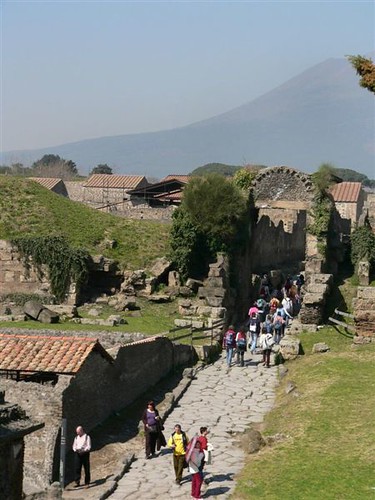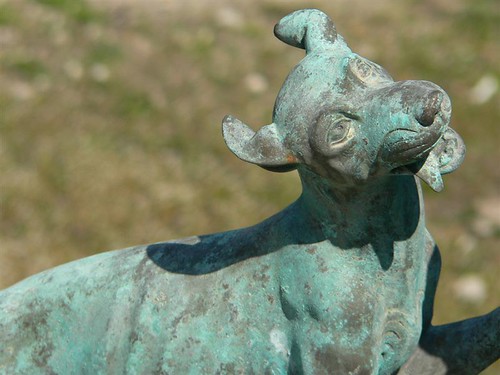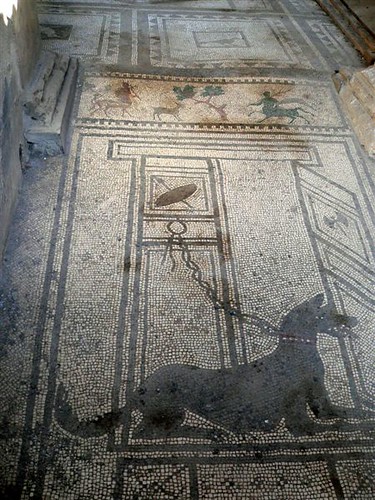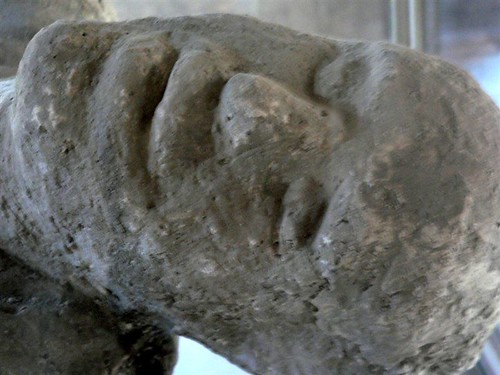 March 16, 2004: Pompeii - The day began with a bit of a disconcerting start driving in Rome rush hour traffic. As I mentioned before, the signage is poor to nonexistent which makes navigating very difficult. In addition, the Romans appear to ignore traffic signals and pedestrians. There are also few lane markers on the streets so the Romans just cram as many cars into the street as possible often with only a hair's breadth between them. Fortunately, the car makers here have developed a special collapsing sideview mirror to minimize the damage from frequent clips. Of course, there is also the swarm of Vespa scooters that weave back and forth any space they can squeeze into, ultimately working their way to the front of the pack by the time they reach the next traffic light.
March 16, 2004: Pompeii - The day began with a bit of a disconcerting start driving in Rome rush hour traffic. As I mentioned before, the signage is poor to nonexistent which makes navigating very difficult. In addition, the Romans appear to ignore traffic signals and pedestrians. There are also few lane markers on the streets so the Romans just cram as many cars into the street as possible often with only a hair's breadth between them. Fortunately, the car makers here have developed a special collapsing sideview mirror to minimize the damage from frequent clips. Of course, there is also the swarm of Vespa scooters that weave back and forth any space they can squeeze into, ultimately working their way to the front of the pack by the time they reach the next traffic light.It was a bit of a challenge finding the on ramp to the proper autostrade but we finally succeeded and started flying toward Pompeii (the speed "suggestion" here is 82 mph). We missed the first turn off and ended up exiting the autostrade at Sarno. We wound our way through the back streets toward Mt. Vesuvius and finally reached the archaeological park.
Although only one fourth of Pompeii has been excavated, it is a large area and we took the rest of the day exploring the ruins. It was fascinating to walk up and down the streets (Roman roads are very hard to walk on - we skirted the along the edge of the roads to walk on the smaller edging stones instead of the large paving stones) and see the fast food stalls, the ancient flour
 mill, and of course the remains of some lovely private villas.
mill, and of course the remains of some lovely private villas.People in Ancient Rome did not have any cooking facilities in their homes. As they lived in tiny apartments without ovens they took wheat to the local baker and had their bread baked there for them. So, it seems that the Ancient Romans often ate out. (Felipe Fernandez-Armesto, author of Food: a History, reminds us that the population of ancient Rome ate more fast food per head of population than we do today in cities like London and New York.) So, there were many hot food shops and taverns where meals could be purchased and consumed.

All the usual fare of the Romans could be found at these shops or Taverna, including hot sausages, bread, cheese, dates and of course, wine.
Another place for the Ancient Romans to eat out was at the baths. They often had food shops, as well as libraries, hair-cutting facilities and other comforts for Roman Citizens." - Hadrians.com
Of course, I found the decor of the Roman eateries much more elegant than the local MacDonald's! I am fascinated by frescos, even the common ones as well as the elaborate vistas that adorn the palatial homes of the wealthy.

The preservationists have replanted several of the large peristyle gardens, such as those at the "House of Loreio Tiburtino" and some of the vineyards have been replanted as well.
Although few statues remain in situ, as an animal lover, I appreciated the replicas (the originals are housed at the Museo Archeologico Nazionale in Naples) of a little bronze dog and boar figures at the House of the Faun
 (Casa del Fauno). It is considered the largest private house excavated so far, featuring two large peristyle gardens and four dining rooms, and once held the famous mosaic of Alexander the Great defeating the Persian King Darius.
(Casa del Fauno). It is considered the largest private house excavated so far, featuring two large peristyle gardens and four dining rooms, and once held the famous mosaic of Alexander the Great defeating the Persian King Darius."The house was built at the height of the Samnite civilization and during the great influence of Hellenistic architecture, showing a fusion of Italian and Hellenistic elements." - Mr. Sedivy's Highlands Ranch History
I had to laugh because all of the tourists were running around waving their maps and consulting each other, trying to find the brothel where many of the erotic frescos were reputed to be located. Unfortunately,the famous brothel
 was roped off because it had begun to collapse, although work was in progress to shore it up.
was roped off because it had begun to collapse, although work was in progress to shore it up.I did see the famous fresco of Priapus at the House of the Vetti.
"Priapus is a god of fertility, protector of horticulture and viticulture. His statue, holding a wooden sickle in his hand, was used in the Roman gardens as scarecrow, and his enormous penis as a threat against thieves.
This god is mainly known for his huge virile member, and the size of it is so enormous that it has been called "column", "twelve-inch pole", "cypress", "spear", "pyramid", and many other names of the same kind referring to the dimensions of his penis. And just as Zeus shows his thunderbolt, Poseidon his trident, Athena her spear, Apollo his golden arrows, Hermes his caduceus, Dionysus his thyrsus, Heracles his club, so Priapus cannot but proudly exhibit his penis, which best represents him, and without which he is weaponless. This is the reason why his privy parts are always shamelessly displayed in erection.
Some believe that the size of the male sexual organ has little or no relevance, but this lustful god has been assumed to think that the greatest advantage with his enormous penis is that no female can be too roomy for him.
When a certain ass once had a contest with Priapus on the matter of the size of their sexual organs, the beast was defeated by the god, and killed by him. Others say that the ass was killed for a different reason; they tell that after a party in the countryside, Priapus tried to ravish the nymph Lotis, and that when everybody was asleep after feasting and drinking, Priapus approached her silently. But when he was close to fulfilling his wish, the saddle-ass of Silenus gave out an ill-timed roar, which made the nymph to start up. Lotis pushed off Priapus and fled, but the only way to escape him was to turn into the flower called lotus. For having caused him to lose this girl, Priapus killed Silenus' ass, and that is why in Lampsacus, a city on the Hellespont in
 northwestern Asia Minor where he was more revered than any other god, they used to sacrifice this animal to the god." - Priapus by Carlos Parada.
northwestern Asia Minor where he was more revered than any other god, they used to sacrifice this animal to the god." - Priapus by Carlos Parada.Although the famous mosaic of the watchdog with the warning "Cave Canem" from the House of the Tragic Poet has been moved to the museum in Naples, the House of P. Paquius Proculus still had its chained watchdog in the entry.
The fresco of a hunting scene still retained much of its vibrant color.
"The large corpus of wall paintings that survive at Pompeii,
 because of the archaeologically useful eruption of Mt. Vesuvius, led a German scholar, Augustus Mau (1882) to develop, during the years of study he put in at Pompeii, a sequence of four painting styles that fit into a specific chronological framework. He designated the different styles as First Style, Second Style, etc. In the House of the Vettii, we will mostly encounter wall paintings of the Third- and Fourth- Styles, therefore the most "modern" styles when the eruption of Pompeii occurred.
because of the archaeologically useful eruption of Mt. Vesuvius, led a German scholar, Augustus Mau (1882) to develop, during the years of study he put in at Pompeii, a sequence of four painting styles that fit into a specific chronological framework. He designated the different styles as First Style, Second Style, etc. In the House of the Vettii, we will mostly encounter wall paintings of the Third- and Fourth- Styles, therefore the most "modern" styles when the eruption of Pompeii occurred.The colors used in the wall paintings at Pompeii were made of plain earth (ochre), minerals (carbonate of copper), and dyes of animal or vegetable origins for Pompeian reds, blues, greens, yellow, and black. Black resulted in a lustrous tone, easily polished, and thus was used in the best rooms to give a luxurious impression. The pigments were often supplemented with a soapy limestone and bonding element to adhere them to the wall. The finished painting was polished with wax to make them shine and preserve them from the incessant bonbardment of smoke and dirt." - Pompeiian Wall Paintings
But, I was sad to note that what few frescos remained in situ at this time were deteriorating rapidly. I'm glad I was able to still see them. I'm afraid Professor Andrew Wallace-Hadrill's estimate of only a few years before the art in the remains of Pompeii completely disappears is probably accurate based on what I observed.
Despite the fact that I had already been overwhelmed by the Colosseum in Rome, I was still quite impressed with both the amphitheater and the small Greek theater in Pompeii.
 The amphitheater was built around 70 BCE to satisfy the entertainment needs of Sulla's veterans who were settled in Pompeii following the Social War (91-88 BCE), a century and a half earlier, when Rome's Italian allies had fought to acquire the benefits of citizenship. However, it also served as a monumental reminder of Roman dominance over the local Samnite population. The nearby town of Nuceria had not rebelled and subsequently was awarded territory confiscated from opposing residents. The friction this arrangement generated came to a head in 59 BCE when a riot erupted between Pompeiians and citizens of Nuceria during a gladiator bout in the amphitheater.
The amphitheater was built around 70 BCE to satisfy the entertainment needs of Sulla's veterans who were settled in Pompeii following the Social War (91-88 BCE), a century and a half earlier, when Rome's Italian allies had fought to acquire the benefits of citizenship. However, it also served as a monumental reminder of Roman dominance over the local Samnite population. The nearby town of Nuceria had not rebelled and subsequently was awarded territory confiscated from opposing residents. The friction this arrangement generated came to a head in 59 BCE when a riot erupted between Pompeiians and citizens of Nuceria during a gladiator bout in the amphitheater."About this time [AD 59] there was a serious fight between the inhabitants of two Roman settlements, Nuceria and Pompeii. It arose out of a trifling incident at a gladiatorial show....During an exchange of taunts--characteristic of these disorderly country towns--abuse led to stone-throwing, and then swords were drawn. The people of Pompeii, where the show was held, came off best. Many wounded and mutilated Nucerians were taken to the capital. Many bereavements, too, were suffered by parents and children. The emperor instructed the senate to investigate the affair. The senate passed it to the consuls. When they reported back, the senate debarred Pompeii from holding any similar gathering for ten years. Illegal associations in the town were dissolved; and the sponsor of the show and his fellow-instigators of the disorders were exiled."
Tacitus, Annals (XIV.17)
 Of course the real horror of the tragedy that befell Pompeii is reflected in the faces of its inhabitants that were overwhelmed by the toxic gases of the pyroclastic flow that swept through Pompeii on the morning of August 25, 79 CE, approximately 18 hours after the inital eruption began.
Of course the real horror of the tragedy that befell Pompeii is reflected in the faces of its inhabitants that were overwhelmed by the toxic gases of the pyroclastic flow that swept through Pompeii on the morning of August 25, 79 CE, approximately 18 hours after the inital eruption began.
"The 79 eruption of Vesuvius had two distinct phases: first a Plinian phase, where material was ejected in a tall column, spread in atmosphere and fell to earth like rain; followed by a Peléan phase where material flowed down the sides of the volcano as fast-moving avalanches of gas and dust, called pyroclastic flow (pyroclasts are rock fragments formed by a volcanic explosion or ejected from a volcanic vent). The term Plinian derives from the name of Pliny the Younger, whose written observations of the 79 eruption form an important part of the historic record of Pompeii. The term Peléan derives from the name of Mount Pelée on the island of Martinique, where the phenomenon of pyroclastic flow was first documented in a 1902 eruption. The pyroclastic flows of the Peléan phase at Pompeii were the primary cause of volcanic damage to walls, however the air-fall pumice and ash fall during the Plinian phase was also significant since the deposits collapsed roofs and buried low structures, shielding them from the effects of the pyroclastic flow that followed.
A Plinian eruption ejects a column of tephra high into the atmoshpere (tephra refers to any material that is ejected from a volcano into the atmosphere), creating a form similar to the mushroom cloud of a nuclear explosion. A Plinian eruption of Vesuvius began at midday on 24 August 79 AD created a Plinian column approximately 20 km (66,000 feet) high. This phase created a rain of ash and pumice over a broad area primarily to the south of Vesuvius, carried by prevailing winds. This phase lasted approximately eighteen hours...""By the morning of 25 August, it is clear that all covered buildings in Pompeii were uninhabitable due to collapsed floors and roofs, and it is likely that there was a mass exodus from the city; of Pompeii's estimated 20,000 residents, only about 2,000 have been found in excavations, and the majority of those have been found on top of the pumice layer [Sigurdsson 1985, p. 352]. The Plinian phase created a nearly deserted city of buildings without roofs or floors, where the bottom story level was submerged in a layer of pumice; this set the stage for the pyroclastic flow of the Peléan phase that began on the morning of 25 August. The Peléan phase brought a much more damaging eruption, in the form of high-temperature avalanches of gas and dust hugging the ground at high velocity." - Volcanic Phenomena at Pompeii, Kirk Martini.

Postscript - December 8, 2005: Although I only saw a couple of human casts at the archaeological park, I saw many more last month when I attended the exhibit "Pompeii: Stories From An Eruption" at the Chicago Field Museum. The cast that displayed the sheer agony of the victim's last moments was not human but that of a dog that
 had been left chained in the House of Orpheus.
had been left chained in the House of Orpheus.The exhibit also included a gladiator's ornate parade armor. The Thracian-style helmet featured scenes of barbarians, prisoners, and trophies. I marveled at the circumference of the greaves (shin guards) adorned with a relief of Athena. The gladiator must have been extremely muscled.
I also enjoyed seeing the Second Style fresco panels from the House of the Cryptoporticus. The panels depicted herms on pedestals against a backdrop of garlands that framed smaller pictures of scenes of the Dionysiac mysteries.
 The bright orange panels with pictures of the muses from the House of Julius Polybius must have brightened the dining
The bright orange panels with pictures of the muses from the House of Julius Polybius must have brightened the dining experience of many Pompeiians and the flowers and trees with golden apples depicted on fragments of the triclinium fresco from the House of the Golden Bracelet reminded me of the beautiful garden frescoes from Livia's villa that I saw at the Museo Nationale di Roma in Rome.
experience of many Pompeiians and the flowers and trees with golden apples depicted on fragments of the triclinium fresco from the House of the Golden Bracelet reminded me of the beautiful garden frescoes from Livia's villa that I saw at the Museo Nationale di Roma in Rome.The remains of a bronze-framed wooden dining couch that was embellished with a bust of the satyr
 Silenus, similar to this one, was also quite impressive.
Silenus, similar to this one, was also quite impressive."Some have asserted that SATYRS were the inhabitants of the islands called Satyrides, being notorious for outraging foreign women. Since these SATYRS were utterly wild men living in certain Mediterranean islands in the vicinity of Italy, the sailors used to do whatever was necessary in order to avoid them. But sometimes, not having any other choice, they were obliged to put in at what they named the Satyrides islands.
According to these sailors (but sailors love to invent tales), the SATYRS had tails upon their flanks almost as long as those of horses. That was not so bad; much worse was that, when they caught sight of visitors, they ran down to the ship uttering loud sounds, and having come on board, they immediately assaulted the female passengers. This behaviour caused such a panic in the crew that on one occasion the sailors decided to get rid of these savages by casting a foreign woman to the island for them to outrage in the most shocking manner, while they sailed away." - Silenus: The Greek Mythology Link
"Because the consumption of wine played a prominent, if not central, role in these banquets, animals and personages connected with Dionysus were appropriate attributes for the adornments of the couches. Silver coins struck as early as the fifth century B.C. in the wine-producing city of Mende in Macedonia represent Dionysus reclining, two-handled wine cup in hand, on the back of a mule as if he were using it as a couch. (Other figures equally fitting for the couches are maenads, the raving women who rush after Dionysus in mountain revels, and satyrs, his part-animal male attendants.) On late Hellenistic and early Imperial Roman couches, the wise old sileni, fully aware of the dangers posed by drunkenness, might be seen as convivial companions to the banqueters reclining on the couches. " - D. G. Mitten, Oberlin College, Allen Memorial Art Museum
Another interesting detail I noticed on a strongbox found in the peristyle of the Villa of Lucius Crassius Tertius was a painting of a face of a creature or demon whose features, especially the distinctive eyes, looked very similar to the demons found in eastern Indian art. I'm afraid the detail does not show up in this image (as with most traveling exhibits, the promoters of this event prohibited guest photography) but it is located in the square panel in the center of the front of the box. The house where the strongbox was found was not luxurious. In fact, some of the walls were not even plastered and it had simple earthen floors. But piles of amphorae discovered there along with a series of commercial weights have led researchers to conclude that the home was the site of a small business engaged in the production of wine, oil, and other agricultural produce. Perhaps the box was received in trade.
distinctive eyes, looked very similar to the demons found in eastern Indian art. I'm afraid the detail does not show up in this image (as with most traveling exhibits, the promoters of this event prohibited guest photography) but it is located in the square panel in the center of the front of the box. The house where the strongbox was found was not luxurious. In fact, some of the walls were not even plastered and it had simple earthen floors. But piles of amphorae discovered there along with a series of commercial weights have led researchers to conclude that the home was the site of a small business engaged in the production of wine, oil, and other agricultural produce. Perhaps the box was received in trade.
When I told my husband that I wanted to see this exhibit he asked why since I had been to Pompeii itself. I told him obviously, since these artifacts were on tour I had not seen them in Pompeii. I was not disappointed!
No comments:
Post a Comment